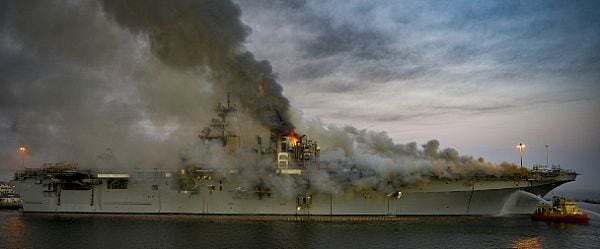ARLINGTON, Va. — The U.S. Navy is paying more attention to its battle damage assessment and repair capabilities, as it considers what it needs in order to win a war against a sophisticated adversary.
Rear Adm. Eric Ver Hage, the commander of the Navy’s Regional Maintenance Center, said the service went so far as to use the burned-out hull of the former amphibious assault ship Bonhomme Richard to practice this work. The ship caught fire in July 2020 and was decommissioned in April 2021.
Speaking on a panel at the Surface Navy Association’s annual conference, he said the service will “often pencil whip that in drills,” assuming battle damage assessment and repairs take place but not actually doing the work during an exercise.
“We’re actually practicing it now in ways that we haven’t before — not just in war games, but with the Bonhomme Richard, as we towed that ship into the Gulf Coast for scrapping. That was a tragedy, of course, but for those 300, 400 final miles of that ship’s journey, that ship had one more opportunity to serve. We had salvage and [regional maintenance center] personnel, mobile dive and salvage units, we had them onboard, they were assessing the damage — they hadn’t seen it before — they were documenting what needed to be done, working through the comms, the [command and control], and then they went pierside and kind of finished it up,” he said.
This won’t be a one-off event, he added.
Ahead of this summer’s Rim of the Pacific multinational exercise in Hawaii, he said a decommissioned ship slated to be sunk in an exercise would first be damaged in a smaller blast so that battle damage personnel can come aboard, tow the ship back to port and run through their assessment work.
“We’ll spend a couple weeks doing that, and then of course when we’re done with that, then it’ll be towed out for its final journey and will be sunk as part of RIMPAC,” Ver Hage said, without naming which ship would be involved in this battle damage training and the sinking event.
He also referred to an ongoing effort in Japan in which U.S. Navy and U.S. Army seek ways to complete repairs faster — a timely need should a ship be damaged during a war and need to return to fight.
Though not damaged in combat, the destroyers Fitzgerald and John S. McCain, each involved in separate collisions, serve as example of how long it can take to repair ships. McCain was towed back to its home port of Yokosuka and repaired locally, which took about 23 months.
Fitzgerald was more extensively damaged and was towed back to Ingalls Shipbuilding in Mississippi — one of two yards that builds the Arleigh Burke destroyers, though not the one where Fitzgerald was constructed. Repairs involved lifting the ship onto land for what amounted to rebuilding portions of the vessel. That took about 25 months.
From the perspective of the maintenance community, Ver Hage said, preparing for a future fight is about infrastructure like dry docks, but “it’s also about the workforce and their skills, and we’re even working through some of the battle damage stuff.”
On the topic of dry docks, he said the Navy doesn’t have enough to conduct its routine work today, let alone emergency work from battle damage — a sentiment echoed by U.S. Fleet Forces Command leader Adm. Daryl Caudle the day before in a separate speech at the SNA conference.
Ver Hage encouraged more capital investment in the private sector to increase dry docks available for Navy surface ships. He noted that the Navy’s graving dock in San Diego, California, which is owned by the service but hosts repair work conducted by private companies, is undergoing modifications so it can accommodate a destroyer.
“Maybe I’ll never need it, but I’m ready to have it, the fleet will have it if we do need it,” he said.
Caudle, following his Jan. 12 speech, told reporters there’s not enough maintenance capacity for routine work, let alone emergent work from battle damage or from accidents, such as when the fast-attack submarine Connecticut struck an undersea mountain in October in the South China Sea.
“Our repair capacity has the pedal to the floor, we are at full throttle. So any time we insert a new ship into that, that’s going to be an applecart-upsetting event, and it’s going to propagate that effect throughout other major availabilities,” the admiral said.
“If I went into conflict, high-end conflict where I had to repair numerous ships simultaneously, I don’t have enough capacity. I don’t have enough dry docks, and I don’t have enough shipyards to get after that,” he added. “So it’s a wartime problem, and it’s a peacetime problem any time we have something that’s unplanned.”
Megan Eckstein is the naval warfare reporter at Defense News. She has covered military news since 2009, with a focus on U.S. Navy and Marine Corps operations, acquisition programs and budgets. She has reported from four geographic fleets and is happiest when she’s filing stories from a ship. Megan is a University of Maryland alumna.





